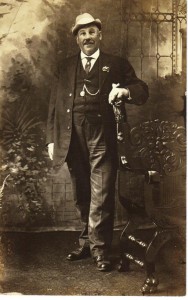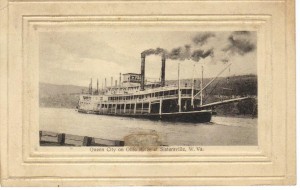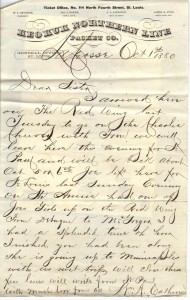I added the biography of a Georgetown gentleman, Charley Poe. He was a jewel of his time.
Archive for October, 2009
Charles Edgar Poe
Saturday, October 31st, 2009More on Methodism in Pittsburgh.
Thursday, October 29th, 2009The Pittsburgh Conference of the Methodist Episcopal Church was organized 15-21 Sep 1825. Until that time, the Baltimore Conference had managed the circuits in southwest PA from Uniontown to Brownsville to Pittsburgh and western VA from Morgantown to Wheeling. [1]
A schism had developed in the church around the authority of the conference Bishop. The Bishop appointed the Presiding Elders. “Reformers” or “radicals” offered a proposal to the conference that the Presiding Elders should be elected by the conference members. The proposal was an attempt to reduce the power of the Bishop. Pittsburgh was the chief center of this agitation. By the time of the General Conference held in Pittsburgh in 1828, the controversy was too great to reconcile. The result was the withdrawal of the reformers who two years later adopted the name The Methodist Protestant Church.
The Georgetown church, founded in 1834, was a Methodist Episcopal Church. Today it is a United Methodist Church.
Reference.
[1] . Wallace Guy Smeltzer, DD, The Story of Methodism in the Pittsburgh Region, The Allegheny-Kiski Printing Co, 1958.
The Golden Age of Steamboating
Friday, October 23rd, 2009I have loaded a brief editorial on the rise and decline of steamboating on the inland rivers. The page is The Golden Age of Steamboating.
Steamboat Photographs
Wednesday, October 21st, 2009The photographs and postcards uncovered to date have been loaded as pages. Most of the photos were snapped by my grandmother who lived in the Ebert home overlooking the Ohio River. Some of the older images, including RPPCs (real photograph post card) and stereoviews, were part of the treasures saved by my mother. Hope you enjoy them. The steamboat photos taken from Georgetown are on page Nash Steamboat Images.
Glass Plate Negatives
Tuesday, October 20th, 2009Recently I had digital images made from 15 glass plate negatives. The date of the photos is 1900 plus and/or minus a year or two or three. The negatives had been stored in an appropriately sized Christmas card box for many years. One plate was cracked and several were damaged. Some images are excellent. Georgetown had one professional photographer, TD Todd. I do not know whether he produced these photographs.
The images are loaded as a page called Poe Glass Plate Negatives under Georgetown Photo Galleries.
Thanks
Saturday, October 17th, 2009I thank you for making the time to visit Georgetown Steamboats. Yesterday, Fri 16 Oct, was my best day to date. Thanks to you my “Visitor” stat hit a superalltimegreatest high since the site opened in mid-Aug. I’m most curious. If you read this post, please comment. A word or two will direct me. More photographs. More river tales. I have identified 73 steamers so I have much more to learn.
The Circuit Rider
Friday, October 16th, 2009I added a page called The Circuit Rider. It is colorful story based on a journal written by a Methodist Episcopal minister’s wife. It describes in detail their two year appointment in Georgetown at the beginning of the Civil War. A fun read.
Why Steamboats?
Tuesday, October 13th, 2009Why did I chose to write about steamboats? Maybe it is a perverse romanticism. Or a passion about the monumentally unimportant.
 This website is my memorial to the riverboat owners and captains who steamed from Georgetown, PA. Their lives, like everything else, will fade from our memory and grow more and more dim with the lapse of time. This site was designed to tell their stories and preserve their memory. If the stories reach numerous people interested in our inland rivers history, they will commemorate the lives of my ancestors and the lives of other rivermen. Men who pitted their skills against the river’s dangers. Men who built boats, ran boats, and made history.
This website is my memorial to the riverboat owners and captains who steamed from Georgetown, PA. Their lives, like everything else, will fade from our memory and grow more and more dim with the lapse of time. This site was designed to tell their stories and preserve their memory. If the stories reach numerous people interested in our inland rivers history, they will commemorate the lives of my ancestors and the lives of other rivermen. Men who pitted their skills against the river’s dangers. Men who built boats, ran boats, and made history.
Letter – Keokuk Northern Line
Saturday, October 10th, 2009I have decrypted a letter dated 1 Oct 1880 written by William Albert Calhoon on the Keokuk Northern Line letterhead .
La Crosse Oct 1st 1880
Dear Sister
I arrived here
on the Red Wing last
Tuesday to go on the Charlie
Cheever with Tom we will
leave here this evening for St
Paul and will be back about
Oct 5th or 6th Joe left here for
St Louis last Sunday evening
on the Str Annie had one of
Joes girls up on the Red Wing
From Dubuque to McGregor I
had a splendid time oh how
I wished you had been along
She is going up to Minneapolis
with us next trip, will close these
few lines will write from St Paul
with much love from all Wm A Calhoon
“Dear Sister” is Parthenia Parr Calhoon (b 16 May 1855 in Georgetown, PA d 10 Jan 1946). She had a twin brother named Joseph MC Calhoon – yes that was his middle name. Joseph never married so I do not know who “one of Joe’s girls” would be mentioned in this letter. The “ Tom” in the letter was an older brother Thomas Franklin Calhoon. Their father Joseph MC Calhoon (b 1823 d 21 Apr 1855) was a steamboat owner and captain who died of cholera while near St Louis. The story of his death and the return of his body to Georgetown, PA is told in the Georgetown tale – The Body.
In 1866 Parthenia Parr Calhoon, the wife of Joseph MC Calhoon, died. Five young children were orphaned. Capt George Washington Ebert , half brother of Parthenia Parr, was appointed guardian of the five Calhoon children. The Calhoon twins, Parthenia and Joseph, were reared in “The Poe House” by Mrs Jacob Poe (Mary Ann (Ebert) Poe, the sister of George W Ebert and half sister of Parthenia Parr). From the 1870 Census Report, I assume the three older boys lived with Capt George W Ebert.
Parthenia Parr Calhoon (b 1855) spent her entire life with her aunt and the Poe family in “The Poe House”. After Jacob Poe and his wife died, Parthenia continued to live in “The Poe House” with Charles Edgar Poe and his daughter Lillian May. George WE Poe and his wife also lived in “The Poe House” at that time. After Charley Poe died, Parthenia lived with her niece Lillian May and Lillian’s uncle, George WE Poe.
It is quite confusing, but important when you think of the names associated with Aunt Parthenia. Calhoon, Parr, Ebert, Poe - major names in Ohio River steamboat history.
The author of the letter, “Wm A”, was an older brother of Aunt Parthenia (William Albert Calhoon (b 13 Jan 1852 d 25 Oct 1889 unmarried)) . He died of “consumption” after spending some time in a hospital in Cairo, IL in Jul 1889. I have two letters dated 5 Jul 1889 written by William Albert to sister Parthenia Parr Calhoon and brother Thomas Franklin Calhoon. These two letters were written on Cherokee Packet Company letterhead four months before his death.
In the Keokuk letter to Parthenia Parr Calhoon, William Albert mentioned several steamers. The construction of the steamer Red Wing was supervised by Jacob Poe according to Capt Way’s Packet Directory. The str Charlie Cheever (officially named Charles Cheever ) was a sternwheeler built in Brownsville, PA where many Poe boats were constructed, but I do not know its owner nor master. The Annie was a sternwheeler built in 1877 for the Keokuk Line. I have found no historical data on her owner or master.
I do not know why William Albert Calhoon was traveling on the upper Mississippi at that time. Whether the Poes and/or Calhoons had any interest in the Keokuk Packet Line or the Keokuk Northern Packet Line is unknown at this time. More research and some luck is required to break through this mystery.
Where was the Civil War won?
Friday, October 2nd, 2009I belong to a couple of Civil War discussion groups. The question “Where was the war won? And who won it?” was asked in my CivWar West group. My response, copied below, caused more activity than the group had generated in months. You be the judge — probably nutty, but possibly insightful, yet I hope interesting in either case.
After considerable thought and analysis, I’ve come to my conclusion. The Civil War was won in:
Pittsburgh = Steeler Country
And it was won by western Pennsylvanian rivermen.
Some believe the momentum of the Civil War changed after victories in the Western Theater, whether Vicksburg or Shiloh. If this premise is true, then what were the major enablers that differed from the east? The major advantages of the Union Army were the tall stack steamers: civilian transports, tinclads, and gunboats, and their men: captains, pilots, engineers, and crews, who operated the transports. The origin of these advantages, and other support goods, was Pittsburgh.
A mindful analysis of the Charles and E Kay Gibson’s “Dictionary of Transports and Combatant Vessels, Steam and Sail, Employed by the Union Army 1861-1868″, indicates that approximately 720 steamboats were employed on the western rivers during the Civil War. The Army Quartermaster built and purchased 105 and chartered 615. Cross referencing those steamboats by name with Capt Frederick Way’s “Way’s Packet Directory, 1848-1994″ revealed that just over 44% of the steamboats were built in Pittsburgh. My definition of “Pittsburgh” is the region on the Ohio and Monongahela Rivers approximately 20 miles down the Ohio and 20 miles up the Mon from Pittsburgh. That region includes boatyards in river towns such as Freedom, Shousetown (no longer exists), Elizabeth (Lewis and Clark keelboat fame), Brownsville, McKeesport, California, Belle Vernon … That region is about 4% of the total run of the Ohio River.
From Gibsons Dictionary I have included all the boats which means packets built as far up the Mississippi as Keokuk, IA and as far down as New Orleans, LA and in Bridgeport, AL on the Tennessee River. So my 40 miles of water surrounding Pittsburgh is competing with all the boatyards on the rest of the Ohio plus nearly the full length of the Mississippi and the Tennessee rivers. Gunboats also skewed the data against Pittsburgh. Gunboats were built specifically for the Quartermaster in strange places such as Oquaka, IL, Burlington, IA, Chatanooga, TN, etc. These sites were not commercial boatyards like those found in Cincinnati, OH, New Albany, IN, and Elizabeth, PA.
The sources used to identify the steamers on the western rivers were the primary sources of Gibson’s Dictionary part 2 and 3 of HR-337 and one secondary source identified as Hurst which refers to a list in “The Battle of Shiloh” by TM Hurst. The Gibsons do not list the build port for the steamers. By cross referencing the name provided by the Gibsons with the build location in Way’s Directory, I have my data.
In addition to the boatyards, Pittsburgh was the major iron works center in the Union. Sixteen enormous steel works produced two-thirds of all the crucible steel. Approximately 60% of the artillery used by the Union Army was forged in Pittsburgh. Rails for the railroad systems were also forged in Pittsburgh, although the railroads contributed no or little advantage in the west. Four inches thick, the iron plates for “iron clad” gunboats were made in Pittsburgh. Theses products, artillery and iron rails and plates, provided the mortar to keep my main conclusion standing.
Without experiencing a single warlike day, Pittsburgh, the cradle of manufacturing and industry, provided the underlying support that changed the momentum of the war. Pittsburgh’s manufacturing base also benefited from steamboat production and their use. Steamboats were used not only to ship goods to market but were used to import raw materials to the local mills.
Note 1: I was surprised that Pittsburgh’s steamboats did not total more than 50%. Alas, I had spent too much time not to respond with the data at hand. For the Missouri River commerce of the late 1860′s, Pittsburgh produced approx 70% of the packets. I was also amazed by the number of packets built in Cincinnati. Far more than any other single site, but far less than the Pittsburgh region according to my definition of the region. I had no idea Cincinnati had such a river history.



